Where nature and man have created the greatest wines...

Where it all began…
“In the south-west corner of France, on a curve of the Garonne river, lie the world capital of wine, the oenophile’s Athens and Rome” Alexis Lichine.
Since ancient times, man has made great use of the exceptional riches of what would become the most prestigious of winemaking regions. Thanks to generous geology and auspicious rainfall, the Bordeaux vineyard charms wine enthusiasts all over the world with its exceptionally diverse range of creamy, flavoursome wines.
To receive the Bordeaux appellation, the grapes must only come from a specific geographic area, and belong to the following grape varieties: Cabernet-Sauvignon, Merlot, Cabernet Franc and Petit Verdot for reds, Sauvignon, Sémillion and Muscadelle for whites. A few other varieties may be used if they do not exceed a certain percentage.
Red wines from vines at least 21 years old that are aged for at least 12 months in oak barrels, and also some white wines, may use the Bordeaux Supérieur appellation.
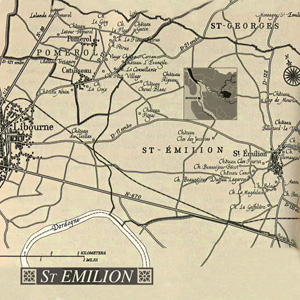
When tradition rhymes with exception…
“Perched above the Dordogne, Saint-Émilion is one of the most lovelier wine towns of the world,” Alexis Lichine
On the right bank of Bordeaux, the Saint-Émilion vineyard is today a UNESCO world heritage site. Centred around the village of the same name whose heritage extols its rich past, it produces some of the world’s most renowned wines. The Merlot grape adapts perfectly to the chalky and clay-calcareous soils and brings to the wine its legendary roundness on the palate and tannic structure.
Saint-Émilion wines are exclusively red. They are characterised by supple flavours and aromas, elegant and velvety, evoking vanilla, sweet spices, strawberries and wild redcurrants. They are perfectly suited and will reveal their character with any type of meat or a varied cheeseboard.
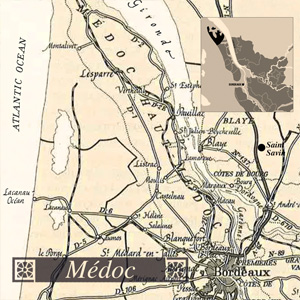
A peninsula of excellence…
“The chateaux of the Médoc in all their diversity of architecture and in the great variety of wines they produce, are among the great sights France offers” Alexis Lichine.
A narrow stretch of land separating the Atlantic Ocean and the Gironde Estuary, Médoc is the birthplace of exceptional wines. Only red wines can use this appellation. The sandy gravelly soil allows the Cabernet-Sauvignon grapes to fully express themselves, giving Médoc its inimitable tannic taste, well-rounded structure and longevity.
Aged 6 to 24 months, sometimes in oak barrels, Médoc wines require between two and ten years to reveal all their hidden treasures. These vary from aromas of red or black summer fruits like strawberry, redcurrant, blackberry or blueberry, to caramel, cocoa, chocolate or even tobacco and also spicy aromas such as pepper, liquorice or eucalyptus.
Wines from Médoc are known for being ideal companions for red meats such as game or lamb.
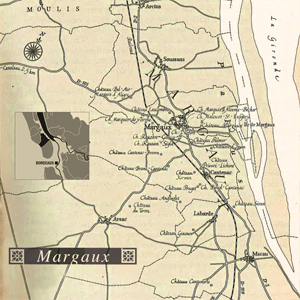
The pearl of Médoc…
“Margaux, at its best, represents the quintessence of Médoc, characterized by an exceptional delicacy, finesse and a lingering echoes of taste often described as evocative of violets” Alexis Lichine.
Margaux is sheltered in the heart of the Médoc vineyard like a jewel protected in its velvet case. Margaux, meaning “pearl” in ancient Greek, is reputed to be the most feminine of Médoc wines because of its delicate nature and unrivalled charm. Combining the character of Cabernet-Sauvignon, the tenderness of Merlot and the subtlety of Cabernet Franc, Margaux is a garnet red when young, tending towards a more distinguished structure with age.
Margaux knows how to toy with the senses and charm with its elegant fruity bouquet and incomparable richness. The name Margaux resonates among the most prestigious appellations.
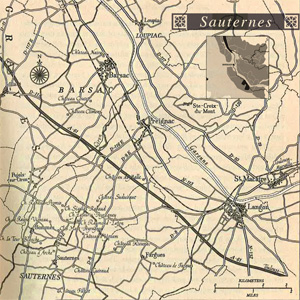
The queen of sweetness…
“Set like a jewel set in the midst of Graves, south of Bordeaux is the most acclaimed sweet-wines region in the world: Sauternes.” Alexis Lichine.
An exceptional micro-climate and man’s expertise have created a sweet wine whose name is enough to stimulate the taste buds of wine lovers all over the world: Sauternes. The white grapes, Sémillon, Sauvignon and Muscadelle, are harvested late to significantly increase their sugar content. Even after vinification, this gives the wine its unequalled sweetness.
The golden colour progressively slides towards amber and the floral and fruity aromas blend to celebrate a complex and balanced bouquet comprising lime blossom, almond, quince and passion fruit. This wine is captivating with its elegant sweetness and exceptional aromas.
The richness of the earth, the generosity of the sun...
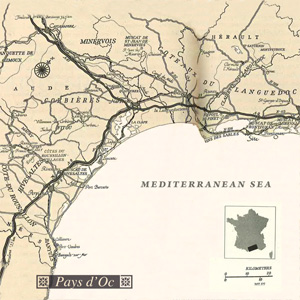
Welcoming wines…
“Although no two Frenchmen will agree on the exact boundaries, there is no disagreement on the connotations of the word: the Midi is the south of deep blue skies contrasted against ochre-red rocks and the subtle shades of silvery greys and greens scrubland that the locals call the “garrigue”.” Alexis Lichine.
In the Languedoc-Roussillon region, the Pays d’Oc vineyard is the birthplace of wines that cleverly combine quality and flavour with accessibility and diversity. From the foothills of the Pyrenees to the Mediterranean coast, the hot and dry climate works with the generous soil. A wide range of grape varieties mean there is something for everyone from this vineyard. White, red or rosé, the Pays d’Oc appellation boasts a broad palette of flavours, aromas and sensations.
Unlike Bordeaux wines, those from the Pays d’Oc are single varietals, meaning that each is made with one grape variety, hence the purity in their aromas. The varieties are, for the most part, Sauvignon Blanc and Chardonnay for the whites and Cabernet-Sauvignon, Merlot and Syrah for the reds.
